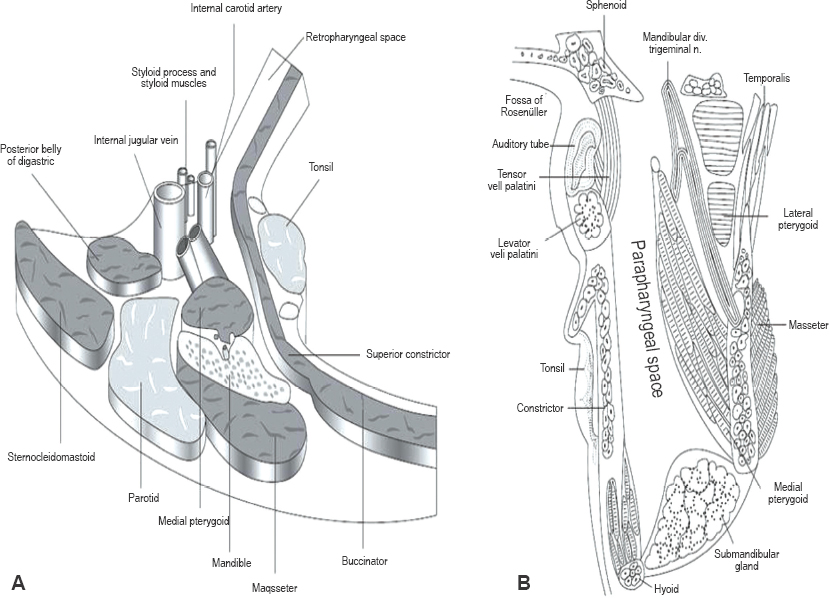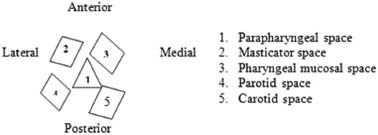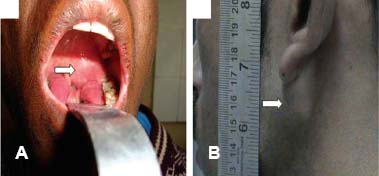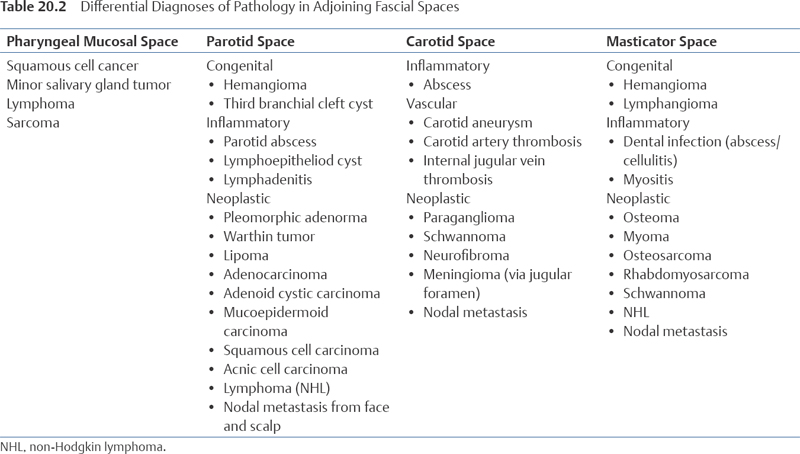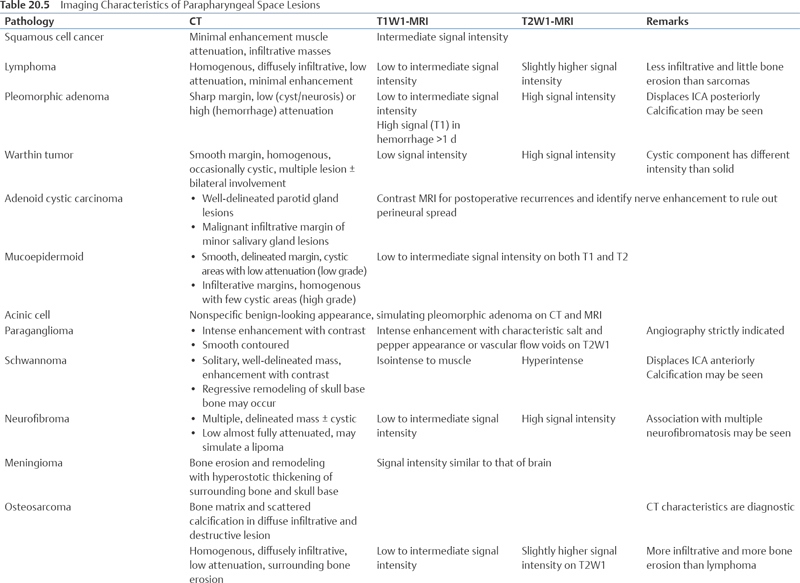20 Core Messages • Parapharyngeal space is a deep-seated fascial space associated with adjoining fascial spaces and the infratemporal fossa having a complex anatomy. • Parapharyngeal space lesions are diagnosed late with imaging and fine-needle aspiration cytology. • Angiography is important to characterize the vascularity of the lesion and for assessment of the cerebral circulation where the internal carotid artery is at risk of being damaged during surgery. • Most parapharyngeal space tumors are benign and can be surgically resected completely with excellent results. The use of transparotid with or without transcervical approach is sufficient in most of the cases. • Primary malignancy of parapharyngeal space carries a relatively satisfactory outcome, while prognosis of a metastatic disease is dismal. • Owing to anatomic complexity and high morbidity associated with surgical clearance especially of an extensive/invasive disease, a balance needs to be maintained between the advantage of surgery and the postoperative deterioration of the quality of life. The parapharyngeal space (PPSp), previously known as lateral pharyngeal space, pharyngomaxillary space, pterygopharyngeal space, pterygomandibular space, or pharyngomasticatory space, is important by virtue of its location, although the tumors of the space are relatively uncommon (0.5% of all head and neck tumors). It is the most complex facial space of the suprahyoid segment of the neck in terms of anatomy. Traditionally, its sister accompaniment, the infratemporal fossa, has been dealt as a separate entity particularly by the anatomists, but pathologically they are often the seat of a single disease. Hence, they can be conceptualized as a single space, both being merely extension of one another. However, it is important to understand a few of the applied anatomic concerns with a surgeon’s perspective. As per the traditional view, the medial pterygoid muscle separates these two compartments anteriorly while a free communication exists in the posterior half. The anatomic aspects are depicted in Table 20.1. The overall anatomic relationship can be resolved by defining the PPSp more accurately as per the radiologists, particularly with regard to the tumor spread. However, summarizing the surgical boundary (Fig. 20.1A, B), the PPSp is bounded medially by the pharyngobasilar fascia and the superior constrictor muscle while laterally by the ramus of the mandible. The prevertebral muscles form the posterior boundary. The styloid process with its attached muscles/fascia along with tensor palati fascial layer arbitrarily divides the PPSp into anterolateral prestyloid and posteromedial poststyloid compartments. Although the classical nomenclature of prestyloid and poststyloid PPSps still exists, current opinion to designate the poststyloid compartment as the carotid space and the prestyloid compartment as the true PPSp is being accepted. The prestyloid compartment ends at the level of the hyoid bone, while the poststyloid compartment continues inferiorly in the neck. The main structures in the prestyloid compartment consist of pterygoid and tensor palati muscles, fat, and the deep lobe of the parotid gland (enclosed in the deep parotid fascia). It is important to note that the masticator space containing the mandibular branch of the trigeminal nerve (V3) is not included in the PPSp but forms its immediate relation. It is formed by the splitting of the deep cervical fascia enclosing the muscles of mastication from the inferior margin of the mandible up to the skull base where it lodges the foramen ovale, a potential channel for tumor spread. Hence, its medial boundary, the medial pterygoid interpterygoid fascia, separates it from the prestyloid compartment of the PPSp. The poststyloid compartment consists of the carotid sheath with the carotid artery, the jugular vein, and the vagus nerve in addition to cranial nerves IX, XI, and XII, the sympathetic chain, and the internal maxillary artery. The fascial subdivisions of the PPSp and the relationship with the adjoining fascial spaces are very important to decide the direction of the spread of the tumor. There are in general four fascial spaces in close relation with the PPSp. These are the pharyngeal mucosal space, masticator space, parotid space, and carotid space. Fig. 20.2 depicts the topographical relation with respect to the PPSp. The pharyngeal mucosal space is somewhat anteromedial to the PPSp, while the masticator space is anterolateral. The parotid space is more lateral to the PPSp than posterolateral while the carotid space is posteromedial. Accordingly, the direction of extension of lesions in the adjoining spaces tends to displace the PPSp in a characteristic pattern. The medial wall of the PPSp is the most pliable of all walls followed by the retromandibular segment of the lateral wall. This results in an oropharyngeal bulge (Fig. 20.3A) and fullness of retromandibular sulcus (Fig. 20.3B), respectively, by any expanding lesion. Table 20.1 Anatomy of the Infratemporal Fossa and the Prestyloid Parapharyngeal Space
Parapharyngeal Space Tumors
Intratemporal Fossa | Prestyloid Parapharyngeal Space | |
Shape boundaries | Inverted pyramid Roof: • Infratemporal surface of greater wing of sphenoid + squamous temporal bone Floor: (arbitrary) • Upper surface of medial pterygoid muscle and its attachment to the medial aspect of the lower part of the ascending ramus of the mandible Medial wall: • Lateral pterygoid plate (anteriorly) • Tensor palati and superior constrictor muscles (posteriorly) Lateral wall: • Inner aspect of zygomatic arch, masseter and temporalis muscle, ascending ramus of the mandible, uppermost part of the deep lobe of the parotid and styloid apparatus Anterior wall: • Posterolateral wall of the maxilla | Triangular Roof: • Angle between superior constrictor muscle and insertion of medial pterygoid muscle into the lateral pterygoid plate with minimal area of temporal bone medial to the foramen ovale and the spinosum Floor: • Descends into the neck medial to the carotid sheath Medial wall: • Lateral wall of the pharynx Lateral wall: • Under surface of medial pterygoid muscle (superiorly) • Deep lobe of the parotid and the styloid (posteriorly) Posteriorly: • Carotid sheath separates it from prevertebral muscles |
Communication with | • Pterygopalatine fossa through pterygomaxillary fissure • Oral cavity through a gap between the anterior edge of the ascending ramus of the mandible and the posterolateral wall of the maxilla • Orbit through inferior orbital fissure | • Retropharyngeal space posteriorly |
Contents | • Medial and lateral pterygoids and temporalis muscles • Maxillary artery with five branches (inferior alveolar, middle meningeal, accessory meningeal, deep auricular, and anterior tympanic) • Pterygoid venous plexus • V3 | • Loose fibro/fatty tissue and salivary glandular tissue • Lower part of the PPSp is traversed by the superior laryngeal nerve and the pharyngeal branch of the vagus nerve • No muscle or lymph nodes are present in the PPSp |
PPSp, parapharyngeal space.
Pathology
It is worth mentioning that the primary tumors of the infratemporal fossa with PPSp extension are quite uncommon and mainly include the extracranial meningioma, fibrosarcoma, chondrosarcoma, lymphoma, angioma, and histiocytosis X.1–3 On the other hand, the primary tumor of the PPSp is more frequent and is mostly the pleomorphic adenoma arising from detached islands of salivary gland tissue.4,5 The lesion secondarily involving the PPSp is usually an extension from surrounding fascial spaces or sometimes metastasis from a distant primary. Table 20.2 enumerates the various pathologies that can be encountered in adjoining fascial spaces.
A review of several large series has revealed that salivary gland tumors (parotid origin), neurogenic tumors, paragangliomas, and lymphoma comprise approximately 80% of PPSp masses while the rest 20% includes other pathologic entities. Johnson et al6 in an analysis of 213 cases from four series found that neurogenous tumors are likely to be encountered more than expected and in accordance schwannomas were seen in 20% of all PPSp tumors. Similarly, Carrau et al7 in their series reported that neurogenic tumors comprised 57% of all PPSp cases. However, malignant tumors in different series were seen in 20,7 27,8 31,9 and up to 52% of all PPSp cases.10 Table 20.3 enumerates the types of pathologies as reported from National Cancer Institute Egypt.10 The more common pathologies need further discussion.
The commonest tumefaction to involve the PPSp is a salivary gland tumor in the prestyloid compartment. It mostly originates from the deep lobe of the parotid gland but can also arise from the isolated salivary glandular tissue in the PPSp itself. In the former case, the parapharyngeal fat is displaced medially while the latter situation is characterized by the presence of a fat plane between the tumor and the deep lobe of the parotid gland. Almost always, the histology reveals a benign pleomorphic adenoma but the occurrence of uncommon pathologies such as oncocytoma, Warthin tumor, or even malignant salivary tumors is well known. Pleomorphic adenoma is a very slow growing tumor and when within the PPSp displaces the parotid gland laterally, the medial pterygoid muscle superolaterally, and the faucial region of the lateral wall of the oropharynx medially. The route of extension from the deep lobe of the parotid gland to the PPSp is through the stylomandibular tunnel, which is formed by the posterior border of the ascending ramus of the mandible, the styloid process, and the stylomandibular ligament. This narrow tunnel gives a constriction in the gross appearance of tumor, resulting in a dumb-bell configuration.11 Such a dumb-bell tumor can be delivered only when the stylomandibular ligament is incised during surgery, thereby releasing the constriction and “widening” the tunnel. Rarely does the pleomorphic adenoma grow large enough to cause bone erosion even if it extends in the infratemporal fossa up to the skull base. On the other hand, malignant salivary gland tumors are likely to grow rapidly and infiltrate the surrounding structures including the pterygoid and masseter muscles (masticator space), infratemporal fossa, skull base and eustachian tube, and facial nerve and auriculotemporal nerves (laterally in the parotid space).
The neurovascular bundle is mainly located in the poststyloid compartment or the carotid space. Hence, the classical neurogenous lumps originate in this space. Overall, the nerves involved by the latter include the vagus nerve, the hypoglossal nerve, and the sympathetic chain. The common neurogenous tumors extending into the PPSp region include schwannoma and neurofibroma while ganglioneuroma and neuroblastoma are rarely encountered. The schwannoma is the commonest neurogenous tumor of the head and neck region. It originates from schwann cells and hence grows along the course of the nerve, taking a somewhat longitudinal spindle shape. Because they are situated along the nerve sheath with no infiltration in the nerve itself (unless a malignant counterpart of the schwannoma infiltrates the nerve), the tumor does not affect the structural or functional integrity of the nerve itself and hence can be surgically dissected away from that particular nerve of origin. Uncommonly, the nerve may theoretically be affected by compression if the tumor is large. Importantly, the histological features of malignancy (polymorphism and increased mitotic figures) often do not correlate with clinical malignancy12–14 and is better decided by the physical examination along with imaging characteristics.
Neurofibroma, on the other hand, originates from the nerve fiber itself including the perineurium and hence situated within the nerve substance involving and splaying the nerve fibrils as it spreads between them.15 Hence, it becomes impossible to surgically excise the tumor without sacrificing the involved nerve segment. This tumor may be associated with multiple subcutaneous nodules and café au lait spots characteristic of von Recklinghausen disease, which is known to be an autosomal-dominant disorder. It is important to note that malignant transformation is relatively uncommon in sporadic neurofibroma, and when it is associated with von Recklinghausen disease, the risk increases to 5 to 15%.16 In reference to neurofibroma of the vagus nerve as a part of von Recklinghausen disease presenting as a PPSp tumor, it is important to examine optic and vestibulocochlear cranial nerves as these are more commonly involved than the vagus itself.
Table 20.3 Frequency of Parapharyngeal Space Tumors
Pathology | % (N = 25) |
Pleomorphic adenoma | 16 |
Mucoepidermoid carcinoma | 16 |
Paraganglioma | 12 |
Neurofibroma | 12 |
Large cell lymphoma | 12 |
Undifferentiated carcinoma parotid | 8 |
Fibrosarcoma | 8 |
Branchial cyst | 4 |
Malignant branchial cyst | 4 |
Chondrosarcoma | 4 |
Benign schwannoma | 4 |
Adapted from reference 10.
Paragangliomas are derived from paraganglionic cells that migrate in close association with autonomic ganglion cell and are seen predominantly in adrenal medulla where they are chromaffin positive producing catecholamines. Those in relation with the PPSp are glomus vagale (inferior vagal ganglion) and glomus jugulare (superior vagal ganglion). The paraganglionic cells are sensitive to changes in pH, and blood gas partial pressure of carbon dioxide more than oxygen. Paragangliomas arising from carotid bodies were known as carotid body tumor or incorrectly as chemodectoma. Not all paragangliomas are catecholamine secreting like adrenal medulla, and this applies more to those presenting as PPSp tumefaction. In gross appearance, the paragangliomas are reddish brown in color, richly vascular, and encapsulated. Histologically, a “Zellballen” pattern of epithelial cell clusters amid fibrovascular stroma is characteristic. They may be sporadic or familial but with female preponderance.
The sporadic variety is usually the vagal paraganglioma from superior and inferior ganglion, arising from the skull base around the jugular foramina and subsequently extending to the PPSp. Accordingly, a large glomus jugulare may be difficult to differentiate from a large glomus vagale.17 Owing to its extreme vascularity and complicated location posing difficulty in surgical excision, it is regarded as a cumbersome disease that needs a complete evaluation.18 Also, vagal paragangliomas are relatively more common catecholomine secretors than is a carotid body tumor. Hence, it is reasonable to draw an index of suspicion for such a possibility during patient evaluation. A history of palpitations, liable hypertension along with tachycardia, and episodes of facial flushing suggest a secreting tumor. In such cases, a serum catecholamine assay and 24-hour urinary vanillylmandelic acid (VMA) estimation clinches the diagnosis. However, the metaiodobenzylguanidine scan may be helpful in borderline cases. A malignant counterpart of paraganglioma is diagnosed on the basis of locally aggressive behavior, as histological differentiation is unreliable and regional metastasis unknown.
The familial variety is inherited in an autosomal-dominant fashion19–21 and carries more than four times the risk of harboring multiple lesions as compared with the sporadic variety.21–23 The simultaneous occurrence of phaeochromocytoma is of great clinical significance,22 and an attempt should be made to search for the latter in the familial variety when clinical features suggest a catecholamine-secreting tumor. A rare association with other endocrine tumors such as parathyroid adenoma and carcinoma thyroid has also been documented. The association with pheochromocytoma may suggest an association with multiple endocrine neoplasia syndrome especially MEN-2B. Hence, a thorough search for other endocrine neoplasias can be rewarding while dealing with the familial variety of paraganglioma.
Apart from the above-mentioned “common” tumors, other nonspecific tumors originating or extending in the PPSp are well known. For example, sarcomas can arise from various mesothelial benign tumors,24 such as liposarcoma, synovial sarcoma,25,26 leomyosarcoma,27 and the more common malignant neurofibroma, especially associated with generalized neurofibromatosis. In general, fibrosarcomas are the most common sarcomas involving the PPSp. Among tumors of vascular origin, hemangiopericytoma28 and intravascular papillary endothelial hyperplasia or Masson disease29 have been reported. Among tumors of the adjoining infratemporal fossa, angiofibroma and extracranial meningioma can extend in the PPSp. The extension of an angiofibroma into the infratemporal fossa through the pterygomaxillary fissure is well known and as it enlarges it may extend in the PPSp downward. PPSp is the second most common site for the occurrence of extracranial meningioma after orbit.30 That presenting in the PPSp originates from the dural sheath surrounding the trunk of the mandibulartrigeminal nerve and exits from the foramen ovale as it presents lower down in the PPSp. Very rarely, intracranial meningiomas may enlarge and extend through a single or multiple foramen of the skull base into the infratemporal fossa; hence, the PPSp displaces the structures in a complex manner. It is extremely uncommon to encounter a mandibular osseous or an amelogenous tumor arising from the ramus of the mandible to bulge into the PPSp.
Lymphatic metastasis commonly occurs in poststyloid PPSp from primary at the nasopharynx, the paranasal sinus (particularly the maxilla), the oropharynx (particularly the base of the tongue), and the parotid salivary gland. As about a third of the patients with undifferentiated nasopharyngeal cancer who develop distant metastasis31 carry a grave prognosis, an effort should be made to properly image the PPSp at regular intervals to detect an occult metastasis. Similarly, an occult metastasis from a maxillary cancer has been suggested to be a contributory factor to the overall poor prognosis. Even papillary thyroid cancer,32 medullary thyroid cancer,33 and cancer of breast33 have been reported to metastasize in the PPSp. Apart from metastasis along lymphatic channels, perineural spread (especially mandibular nerve) can be occasionally seen with adenoid cystic carcinoma or adenocarcinoma.
Infections involving the PPSp are seen as a part of the cellulites involving adjacent fascial spaces, most notably the masticator space with most commonly an odontogenic source.
Patient Work-Up
Clinical Features
The characteristic picture of a true PPSp tumefaction is the medial displacement of the lateral oropharyngeal wall including the tonsil (Fig. 20.3A). This is seen most often with the tumors of the deep lobe of the parotid gland, and a diameter of at least 3 cm is suggested for such a mass to be apparent intraorally.34,35 Large tumors of the superficial lobe of the parotid gland may also present intraorally (dumb-bell tumors)11 but more commonly present as neck swelling behind the angle of the mandible, often raising the ear lobule (Fig. 20.3B). The common symptoms related to intraoral expansion are foreign body sensation, subjective dysphasia, alteration of voice, and even obstructive sleep apnea,34,36 Pharyngeal mucosal space tumors involving the PPSp laterally present predominantly with oropharyngeal symptoms and that too early in the course of disease.
The symptoms arising from an adjoining pathology of masticator space are characterized by trismus and swelling in neck/face. The trismus usually results from the involvement of pterygoid muscles by inflammation (infection), adjacent compression by benign tumor, or by malignant infiltration. Carotid space tumors usually present as a neck swelling, particularly the carotid body paraganglioma and nerve sheath tumor. These tumors may compress the adjoining nerves to present with cranial nerve palsies of different combinations. Similarly, the extension of such tumors superiorly toward the skull base may involve the jugular foramen, leading to jugular foramen syndromes involving cranial nerves (IX through XII) with or without the sympathetic chain (Vernet: IX, X, and XI; Schmidt: X and XI; Hughlings Jackson: X, XI, and XII; Collet-Sicard: IX, X, XI, and XII; Villaret: IX, X, XI, and XII, Horner syndrome). Unlike the developed world, it is very common in underprivileged countries to find extensive/advanced malignancy with a varied combination(s) of symptoms. In addition, superior-based tumors of the carotid space may compress the cartilaginous part of the eustachian tube, causing middle ear problems (conductive deafness).
The occurrence of pain is common and is usually the result of nerve compression/invasion or a consequence of expansion of fascial spaces in the case of abscess/cellulites/inflammation, causing irritation. Other characteristic features of infection including fever and toxemia may be well evident. The associated pain may even lead to odynophagia at times while hoarseness of voice as a result of vagus involvement may be the initial presenting complain as well. Glossopharyngeal neuralgia with syncope is a theoretical possibility in parapharyngeal malignancy,37 and this rare symptom complex has been reported in 30 cases of head and neck cancer till date. Table 20.4 summarizes an institutional experience10 of presenting features of PPSp tumors. The general examination should specially focus on the presence of palpitation, tachycardia, hypertension (catecholamine secreting), and presence of pulsatile lesion (carotid aneurysm) or arterial bruit (carotid body paraganglioma).
Investigations
The main investigating modalities consist of fine-needle aspiration cytology (FNAC), computed tomography (CT)/magnetic resonance imaging (MRI), and occasionally angiography. Currently, ultrasonography has become an indispensable tool at many centers and incisional biopsy is rarely required.
Table 20.4 Clinical Presentation of Parapharyngeal Space Tumors
Symptoms/Signs | % (N = 25) |
Neck swelling | 72 |
Parotid swelling | 28 |
Otalgia | 24 |
Facial palsy | 16 |
Oral swelling | 8 |
Dysphagia | 8 |
Dysarthria | 4 |
Horner syndrome | 4 |
Adapted from reference 10.
Fine-Needle Aspiration Cytology
In general, FNAC is the mainstay of immediate tissue diagnosis in the case of neck swellings. The same stands true for a PPSp tumefaction that presents as either a neck swelling or an oropharyngeal mass. In our tertiary care center in India, a few of the cases referred as a parapharyngeal tumor have revealed only chronic abscess on needle aspiration. Also, a theoretical possibility of aneurysm needs to be considered when the aspirate is frank blood. Our archival records indicate a single mortality with a PPSp aneurysm that was drained intraorally as a peritonsillar/parapharyngeal abscess. Such confusions of a tumor for an abscess or vice versa may be encountered more in the developing world owing to a higher prevalence of infection. A large tumor presenting in the PPSp does not create any difficulty in FNAC while a small tumor with minimal oropharyngeal presentation may be difficult to approach. Under such situation, we primarily carry out ultrasound-guided FNAC or even a CT-guided approach in case it fails. The majority of our patients are diagnosed on the basis of FNAC alone, but there are some limitations as well. Indian authors have reported an accuracy rate of 88% with FNAC,38 which has been shown to improve with the addition of CT to the tune of 92%.39 To reduce the diagnostic dilemma resulting from sampling errors or false-negative results, the histopathologists at our institute themselves collect (and examine) the aspirate from the patients. The pathologist may repeat such aspiration in the same sitting if a sufficient cytological material for an affective diagnosis cannot be obtained in the first instance. Apart from patient-related factors, an “inconclusive” tap is often seen with carotid body tumor where the desired cytological material is grossly diluted by the presence of blood and a dry tap is often encountered in recurrence after radiation therapy. Such situations are subject to be investigated by other means such as angiography and imaging. Immunocytochemistry is a valuable adjunct in some cases, but it is unfortunately not available at the majority of centers.
Imaging
Although a debate exists whether CT or MRI should be used as the primary modality, in reality both are equally good in assessing the PPSp.40,41 While MRI provides a better tumor differentiation and better visualization of PPSp fat,4 CT scan better delineates bony erosions that are critical with respect to the adjoining infratemporal fossa/skull base involvement. MRI also shows a better relationship of the mass to surrounding structures, particularly to the major blood vessels. At our institution in India, the cost factor prohibits the use of MRI as a primary modality of imaging and hence we use CT scanning for this purpose instead. Only if required we advise MRI; otherwise, our experience with CT scan is very satisfying. Image-guided FNAC is possible only with CT scan. However, a few studies have revealed a better anatomic localization with MRI—95 vs. 84% with CT scan.42 In general, low-attenuation areas denote necrosis while high-attenuation areas reflect hemorrhage. The lack of visualization of a fat plane may indicate a tumor originating in the deep lobe of the parotid gland or a large tumor that is either compressing this plane or, rarely, invading it. MRI is superior to CT in such differentiation, and high-resolution images are often essential. We opt for MRI (a) to know the tissue details in the case of diagnostic dilemmas such as accompanying vascularity that needs to be anticipated before surgery. The ability of MRI to visualize the tumor in three planes can be useful (a) in assessing carotid encasement, (b) in case of questionable recurrence where previous irradiation has been used, and (c) to assess the extensive tumor involvement of the infratemporal fossa and skull base. With the advances in imaging techniques, spiral CT consecutive volume data sets are useful for a 3-dimentional (3-D) assessment of a PPSp tumor.43 In addition, the value of a positron emission tomography scan cannot be overemphasized in the case of questionable recurrence in the PPSp. The imaging characteristics of PPSp pathologies are depicted in Table 20.5.
As a radiological approach of diagnosis, the PPSp is considered as being located centrally surrounded by four fascial spaces and an understanding of interrelationships allows a logical approach to differentiate lesions arising in different spaces (Fig. 20.2). Unlike infiltrative malignancies (particularly squamous cell carcinoma) that tend to spread across fascial boundaries (Fig. 20.4), other tumors tend to be localized by fascial compartments. The displacement pattern of fat in the PPSp suggests the site of origin of the primary lesion, and the differential diagnoses can be shortlisted on the basis of the contents of that particular fascial space (Table 20.2). Tumors of pharyngeal mucosal space originate from the wall of the space and hence no clear delineation exists between it and the tumor. Benign and less aggressive tumors are likely to displace PPSp fat posterolaterally while infiltrating lesions diffusely replace it.
The tumor of the masticator space tends to displace the fat posteromedially. Because inflammatory pathology is most common, a CT scan should be regarded as the primary modality of imaging because abscess, dental infection, and osteomyelitis are better visualized on CT than on MRI. However, MRI is better suited to rule out perineural spread along the mandibular division of the trigeminal nerve. The direct evidence suggesting perineural spread can be nerve enlargement or enhancement as such or indirectly by the enlargement of the foramen ovale or denervation atrophy of muscles of mastication. Rhabdomyosarcoma should always be suspected if a child presents with a solid tumor in the masticator space. A parotid space tumor is likely to displace PPSp fat medially (Fig. 20.5), and the most common lesion is the parotid salivary gland neoplasm that has been discussed before.
The suprahyoid part of the carotid space is in direct relation with the PPSp, and a relative anatomic relationship amid its contents is helpful in deciding the precise anatomic origin of the lesion. The vagus nerve lies posterolateral to the carotid artery while the sympathetic trunk is posteromedial. Accordingly, the tumor arising from the vagus nerve would displace the carotid artery anteromedially while an uncommon tumor from the sympathetic chain would displace the artery anterolaterally. In general, tumors of the suprahyoid carotid space displace the PPSp fat and the internal carotid artery anteriorly and the internal jugular vein laterally. The two most common tumors of the carotid space are paraganglioma and nerve-sheath tumors. Also, it is not uncommon to mistake a dominant jugular vein or tortuous carotid artery for a pathology otherwise. Angiography under such circumstances resolves the issue. The common types of paragangliomas seen in the carotid space are carotid body tumor in the infrahyoid neck, and glomus vagale and glomus jugulare in the suprahyoid neck opposing the PPSp. Carotid body tumor tends to splay the carotid fork in the infrahyoid neck, whereas glomus vagale displaces the internal carotid artery anteriorly. Also, a feeding vessel from the ascending pharyngeal artery may be demonstrable in the latter while the former derives its blood supply from vasa vasorum. The characteristic feature of paraganglioma that differentiates it from nerve-sheath tumor is the presence of serpigenous flow voids, which, in turn, are apparent in MRI only if the tumor is at least 2 cm in size. Also, being more vascular, the paraganglioma enhances much more than a nerve-sheath tumor in a contrast-enhanced CT scan. MRI appearance of smooth margins of the paraganglioma can be used to differentiate it from vascular metastasis.4
< div class='tao-gold-member'>
